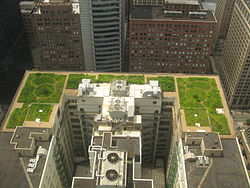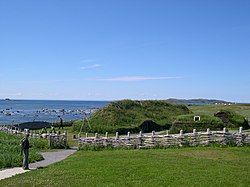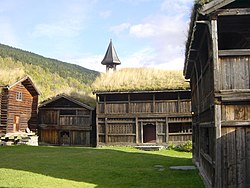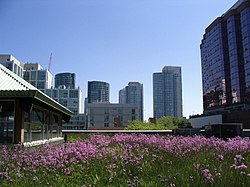Green roof
From Wikipedia, the free encyclopedia
| This article needs additional citations for verification. Please help improve this article by adding reliable references (ideally, using inline citations). Unsourced material may be challenged and removed. (December 2008) |
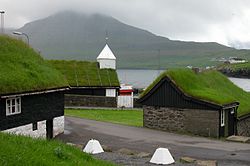
A green roof is a roof of a building that is partially or completely covered with vegetation and soil, or a growing medium, planted over a waterproofing membrane. This does not refer to roofs which are merely colored green, as with green roof shingles. It may also include additional layers such as a root barrier and drainage and irrigation systems.
Container gardens on roofs, where plants are maintained in pots, are not generally considered to be true green roofs, although this is an area of debate. Rooftop ponds are another form of green roofs which are used to treat greywater.
The term green roof may also be used to indicate roofs that use some form of "green" technology, such as solar panels or a photovoltaic module. Green roofs are also referred to as eco-roofs, vegetated roofs, living roofs, and greenroofs.
Contents |
[edit] Benefits

Green roofs are used to:
- Grow fruits, vegetables, and flowers
- Reduce heating (by adding mass and thermal resistance value) and cooling (by evaporative cooling) loads on a building — especially if it is glassed in so as to act as a terrarium and passive solar heat reservoir
- Increase roof life span
- Reduce stormwater run off — see water-wise gardening
- Filter pollutants and carbon dioxide out of the air — see living wall
- The soil and plants on green roofs help to insulate a building for sound; the soil helps to block lower frequencies and the plants block higher frequencies.[2]
- Filter pollutants and heavy metals out of rainwater
- Increase wildlife habitat in built-up areas — see urban wilderness
A green roof is often a key component of an autonomous building.
A 2005 study by Brad Bass of the University of Toronto showed that green roofs can also reduce heat loss and energy consumption in winter conditions.[3]
In a recent study on the impacts of green infrastructure and in particular green roofs in the Greater Manchester area, researchers found that adding green roofs will help keep temperatures down, particularly in urban areas: “adding green roofs to all buildings can have a dramatic effect on maximum surface temperatures, keeping temperatures below the 1961-1990 current form case for all time periods and emissions scenarios. Roof greening makes the biggest difference…where the building proportion is high and the evaporative fraction is low. Thus, the largest difference was made in the town centers.” [4]
[edit] Types

Green roofs can be categorized as"semi-intensive", intensive, or extensive, depending on the depth of planting medium and the amount of maintenance they need. Traditional roof gardens, which require a reasonable depth of soil to grow large plants or conventional lawns, are considered "intensive" because they are labour-intensive, requiring irrigation, feeding and other maintenance. Intensive roofs are more park-like with easy access and may include anything from kitchen herbs to shrubs and small trees[5]. "Extensive" green roofs, by contrast, are designed to be virtually self-sustaining and should require only a minimum of maintenance, perhaps a once-yearly weeding or an application of slow-release fertiliser to boost growth. Extensive roofs are usually only accessed for maintenance[6]. They can be established on a very thin layer of "soil" (most use specially formulated composts): even a thin layer of rockwool laid directly onto a watertight roof can support a planting of Sedum species and mosses.
Another important distinction is between pitched green roofs and flat green roofs. Pitched sod roofs, a traditional feature of many Scandinavian buildings, tend to be of a simpler design than flat green roofs. This is because the pitch of the roof reduces the risk of water penetrating through the roof structure, allowing the use of fewer waterproofing and drainage layers.
[edit] History and use
Modern green roofs, which are made of a system of manufactured layers deliberately placed over roofs to support growing medium and vegetation, are a relatively new phenomenon. However, green roofs or sod roofs in Northern Scandinavia have been around for centuries. The modern "trend" started when green roofs were developed in Germany in the 1960s, and have since spread to many countries. Today, it is estimated that about 10% of all German roofs have been “greened.”[7] Green roofs are also becoming increasingly popular in the United States, although they are not as common as in Europe.
A number of European Countries have very active associations promoting green roofs including Germany, Switzerland, the Netherlands, Italy, Austria, Hungary, Sweden and the UK.[8] Outside of Germany the City of Linz in Austria has been paying developers to install green roofs since 1983 and in Switzerland it has been a federal law since the late 1990s. In the UK their up-take has been slow but a number of cities have developed policies to encourage their use, notably in London and Sheffield.
Many green roofs are installed to comply with local regulations and government fees, often regarding stormwater runoff management.[9] In areas with combined sewer-stormwater systems, heavy storms can overload the wastewater system and cause it to flood, dumping raw sewage into the local waterways. Green roofs decrease the total amount of runoff and slow the rate of runoff from the roof. It has been found that they can retain up to 75% of rainwater, gradually releasing it back into the atmosphere via condensation and transpiration, while retaining pollutants in their soil.[10] Elevation 314, a new development in Washington D.C., uses green roofs to filter and store some of its stormwater on site, avoiding the need for expensive underground sand filters to meet D.C. Department of Health stormwater regulations.
Combating the urban heat island effect[11] is another reason for creating a green roof. Traditional building materials soak up the sun's radiation and re-emit it as heat, making cities at least 4 degrees Celsius (7 °F) hotter than surrounding areas. On Chicago's City Hall, by contrast, which features a green roof, roof temperatures on a hot day are typically 14–44 degrees Celsius (25–80 °F) cooler than they are on traditionally roofed buildings nearby.[12]
Green roofs are becoming common in Chicago, as well as Atlanta, Portland, and other United States cities, where their use is encouraged by regulations to combat the urban heat island effect. In the case of Chicago, the city has passed codes offering incentives to builders who put green roofs on their buildings. The Chicago City Hall green roof is one of the earliest and most well-known examples of green roofs in the United States; it was planted as an experiment to determine the effects a green roof would have on the microclimate of the roof. Following this and other studies, it has now been estimated that if all the roofs in a major city were "greened," urban temperatures could be reduced by as much as 7 degrees Celsius.[13]
Green roofs have also been found to dramatically improve a roof’s insulation value. A study conducted by Environment Canada found a 26% reduction in summer cooling needs and a 26% reduction in winter heat losses when a green roof is used.[14] In addition, greening a roof is expected to lengthen a roof’s lifespan by two or three times, according to Penn State University’s Green Roof Research Center.[7]
Rooftop water purification is also being implemented in green roofs. These forms of green roofs are actually treatment ponds built unto the rooftops. They are built either from a simple substrate (as being done in Dongtan[15]) or with plant-based ponds (as being done by WaterWorks UK Grow System[16] Waterzuiveren.be[17] Plants used include calamus, Menyanthes trifoliata, Mentha aquatica, etc.[18])
Green roofs also provide habitats for plants, insects, and animals that otherwise have limited natural space in cities. Even in high-rise urban settings as tall as 19 stories, it has been found that green roofs can attract beneficial insects, birds, bees and butterflies. Rooftop greenery complements wild areas by providing "stepping stones" for songbirds, migratory birds and other wildlife facing shortages of natural habitat.
[edit] Brown roofs
Industrial brownfield sites can be valuable ecosystems, supporting rare species of plants, animals and invertebrates. Increasingly in demand for redevelopment, these habitats are under threat. "Brown roofs" can partly mitigate this loss of habitat by covering the flat roofs of new developments with a layer of locally sourced material. In Switzerland it is common to use alluvial gravels from the foundations and in London a mix brick rubble and some concrete has been used. Although the original idea was to allow the roofs to self colonise, they are now seeded to increase their biodiversity potential in the short term. The roofs are colonised by spiders and insects, many of which are becoming extremely rare in the UK as such sites are developed and provide a feeding site for insectivorous birds. Laban, a centre for contemporary dance in London, has a brown roof specifically designed to encourage the national rare Black Redstart.[19] (In 2003 Laban won the coveted RIBA Stirling Prize.) The highest green roof [160m] to act as nature reserve in the world is on the Barclays Bank HQ.[20] This has been designed using the principles of the brown roof idea and is already home to a range of rare invertebrates.
[edit] Examples

One of the largest expanses of extensive green roof is to be found in the USA, at Ford Motor Company's River Rouge Plant, Dearborn, Michigan, where 42,000 square metres (450,000 sq ft) of assembly plant roofs are covered with sedum and other plants, designed by William McDonough. Built over Millennium Park Garage, Chicago's 24.5-acre (99,000 m2) Millennium Park is considered one of the largest intensive green roofs.[1] Other well-known American examples include Chicago’s City Hall and the Gap headquarters in San Bruno, CA. Recently, the American Society of Landscape Architects retrofitted their existing headquarters building in Washington, D.C. with a green roof designed by landscape architect Michael Van Valkenburgh.[2]
Another example of a green roof in the United States is the Ballard Library in Seattle. The landscape architect was Swift & Co. and the building architect was Bohlin Cywinski Jackson. This green roof has over 18,000 plants to help with insulation and reduce runoff. The plants which are found on the roof include Achillea tomentosa (Woolly yarrow), Armeria maritima (Sea pink, sea thrift), Carex inops (pensylvanica) (Long-stoloned sedge), Eriphyllum lanatum (Oregon sunshine), Festuca rubra (Red creeping fescue), Festuca idahoensis (Idaho fescue), Phlox subulata (Creeping phlox), Saxifrage cespitosa (Tufted saxifrage), Sedum oreganum (Oregon stonecrop), Sedum album (White stonecrop), Sedum spurium (Two-row stonecrop), Sisyrinchium idahoensis (Blue-eyed grass), Thymus serphyllum (Thyme), Triteleia hyacintha (Fool's onion).
Switzerland has one of Europe's oldest green roofs, created in 1914 at the Moos lake water-treatment plant, Wallishofen, Zürich. Its filter-tanks have 30,000 square metres (320,000 sq ft) of flat concrete roofs. To keep the interior cool and prevent bacterial growth in the filtration beds, a drainage layer of gravel and a 15 cm (6 in) layer of soil was spread over the roofs, which had been waterproofed with asphalt. A meadow developed from seeds already present in the soil; it is now a haven for many plant species, some of which are now otherwise extinct in the district, most notably 6,000 Orchis morio (green-winged orchid). More recent Swiss examples can be found at Klinikum 1 and Klinikum 2, the Cantonal Hospitals of Basel, and the Sihlpost platform at Zürich's main railway station.
What is believed to be the world's first green roof botanic garden was set up in Augustenborg, a suburb of Malmö, in May 1999. The International Green Roof Institute (IGRI) opened to the public in April 2001 as a research station and educational facility. (It has since been renamed the Scandinavian Green Roof Institute (SGRI), in view of the increasing number of similar organisations around the world.) Green roofs are well-established in Malmö: the Augustenborg housing development near the IGRI botanic garden incorporates green roofs and extensive imaginative landscaping of streams, ponds and soakaways between the buildings to deal with storm water run-off.

The new Bo01 urban residential development (in the Västra Hamnen (Western Harbour) close to the foot of the iconic Turning Torso office and apartment block, designed by Santiago Calatrava) is built on the site of old shipyards and industrial areas, and incorporates many green roofs.
British examples can be found at the University of Nottingham Library, and in London at the Horniman Museum and Canary Wharf. The Ethelred Estate, close to the River Thames in central London, is the British capital's largest roof-greening project to date. Toxteth in Liverpool is also a candidate for a major roof-greening project.
In France, a huge green roof of roughly 8,000 square metres (86,000 sq ft) has been incorporated into the new museum L'Historial de la Vendée which opened in June 2006 at Les Lucs-sur-Boulogne.
The new California Academy of Sciences building in San Francisco's Golden Gate Park has a green roof that provides 2.5 acres (10,000 m2) of native vegetation designed as a habitat for indigenous species, including the threatened Bay checkerspot butterfly. According to the Academy's fact sheet on the building,[21] the building consumes 30-35% less energy than required by code.
The roof to Banco Santander's headquarters in Madrid, Spain is currently home to Europe's biggest green roof at just ove 100,000sqm in size. The roof was made using a mix of both extensive and intensive planting systems.
Also, some green roofs are found on Icelandic Farms and buildings. Iceland is plentiful of these grass roofs.
[edit] Costs
A properly designed and installed green roof system can cost 5 to 10 dollars per square foot[22]. The cost depends on what kind of roof it is, the structure of the building, and what plants can grow on the material that is on top of the roof. In the Spring 2007 issue of the Green Roof Infrastructure Monitor (Green Roofs for Healthy Cities web site), Jörg Breuning reflects the wind and fire loads of green roofs and how German insurance companies handle extensive green roofs.
Some cost can also be attributed to maintenance. Extensive green roofs have low maintenance requirements but they are generally not maintenance free. German research has quantified the need to remove unwanted seedlings to approximately 0,1 min/(m²*year).[23] Maintenance of green roofs often includes fertilisation to increase flowering and succulent plant cover. If aesthetics is not an issue, fertilisation and maintenance is generally not needed. Extensive green roofs should only be fertilised with controlled release fertilisers in order to avoid pollution of the stormwater. Conventional fertilisers should never be used on extensive vegetated roofs.[24][25] German studies have approximated the nutrient requirement of vegetated roofs to 5gN/m². It is also important to use a substrate that does not contain too much available nutrients. The FLL-guidelines specify maximum allowable nutrient content of substrates.[26]
[edit] By country
[edit] Egypt
In Egypt, soil-less agriculture is used to grow plants on the roofs of buildings. No soil is placed directly on the roof itself, thus eliminating the need for an insulating layer; instead, plants are grown on wooden tables. Vegetables and fruit are the most popular candidates, providing a fresh, healthy source of food that is free from pesticides.[27]
A more advanced method (aquaponics) is being used experimentally at some places in Egypt is farming fish next to the plants in a closed cycle. This allows the plants to benefit from the ammonia excreted by the fish, helping the plants to grow better and at the same time eliminating the need for changing the water for the fish, because the plants help to keep it clean by absorbing the ammonia. The fish get some nutrients from the roots of the plants.
[edit] United Kingdom
In the United Kingdom, green roofs are often used in built up city areas where residents and workers often do not have access to gardens or local parks. They have also been used by companies such as Rolls-Royce Motor Cars, who have one of the biggest green roofs in Europe to help their factory blend into its countryside surroundings.
[edit] Disadvantages
Green roofs have more demanding structural standards. Some existing buildings cannot be retrofitted with a green roof because of the weight load of the soil and vegetation. Depending on what kind of roof it is, the maintenance costs could be higher. Green roofs also place higher demands on the waterproofing system of the structure both because water is retained on the roof and due to the possibility of roots penetrating the waterproof membrane."However a sedum covering doesn't need water to be retained on the roof as these plants can tolerate long periods without rainfall, so a drainage layer will combat this particular problem"(Chris Sorrell). Installing adequate waterproofing systems and root barriers can increase the cost of the roof.
[edit] See also
- Arcology
- Eco-village
- Energy-efficient landscaping
- Hanging Gardens of Babylon
- Ralph Hancock, Designer, The Rockefeller Center Roof Gardens
- Roof garden
- Sod roof, Traditional roof in Scandinavia
- Sustainable city
[edit] References
- ^ California (magazine of the University of California Alumni Association), Sept/Oct 2008, cover and pp. 52-53
- ^ Green Roofs for Healthy Cities: About Green Roofs. www.greenroofs.org
- ^ "University of Toronto - News@UofT - Green roofs in winter: Hot design for a cold climate (Nov 17/05)". http://www.news.utoronto.ca/bin6/051117-1822.asp. Retrieved on 2008-06-10.
- ^ Gill, S.E., J.F. Handley, A.R. Ennos and S. Pauleit. “Adapting Cities for climate Change: The Role of the Green Infrastructure.” Built Environment Vol 33 No. 1, page 122-123.
- ^ "City Green Building - Green Roofs." Seattle Department of Planning and Development. 12 Feb. 2007. 3 Nov. 2008 <http://www.seattle.gov/dpd/greenbuilding/ourprogram/resources/technicalbriefs/dpds_009485.asp#whatis>.
- ^ "City Green Building - Green Roofs." Seattle Department of Planning and Development. 12 Feb. 2007. 3 Nov. 2008 <http://www.seattle.gov/dpd/greenbuilding/ourprogram/resources/technicalbriefs/dpds_009485.asp#whatis>.
- ^ a b "Penn State Green Roof Research: About Green Roofs". http://hortweb.cas.psu.edu/research/greenroofcenter/history.html. Retrieved on 2008-06-10.
- ^ www.efb-greenroof.eu
- ^ Earth Pledge. Green Roofs : Ecological Design and Construction. Atglen, PA: Schiffer Pub., 2005.
- ^ "Green Roofs". http://www.epa.gov/heatisland/strategies/greenroofs.html. Retrieved on 2008-06-10.
- ^ "Here Comes Urban Heat". http://science.nasa.gov/headlines/y2000/essd16mar_1m.htm. Retrieved on 2008-06-10.
- ^ "Plant-Covered Roofs Ease Urban Heat". http://news.nationalgeographic.com/news/2002/11/1115_021115_GreenRoofs_2.html. Retrieved on 2008-06-10.
- ^ "Is that a Garden on Your Roof? - Enterprise The Future of Energy - MSNBC.com". http://msnbc.msn.com/id/6002705/site/newsweek/. Retrieved on 2008-06-10.
- ^ "Green Roofs for Healthy Cities - About Green Roofs". http://www.greenroofs.net/index.php?option=com_content&task=view&id=26&Itemid=40. Retrieved on 2008-06-10.
- ^ Dongtan green roofs filter water
- ^ WWUK rooftop water purification with plants
- ^ Waterzuiveren.be building water-purifying roofponds
- ^ Description of plants used in water-purifying rooftop ponds
- ^ Case Study - Laban Dance Centre, Deptford SE8
- ^ Green roof case study - Barclay Bank HQ. Canary Wharf
- ^ "California Academy of Sciences - Newsroom". http://www.calacademy.org/geninfo/newsroom/releases/2005/Green_building_facts.html. Retrieved on 2008-06-10.
- ^ Carter T, Keeler A Life-cycle cost-benefit analysis of extensivevegetated roof systems. Journal of Environmental Management(in press)
- ^ Kolb, W. and T. Schwarz (2002). Gepflegtes grün auf dem dach Deutscher Gartenbau(7): 32-34.
- ^ Emilsson, T., Czemiel Berndtsson, J., Mattsson, J-E and Rolf, K., 2007 Effect of using conventional and controlled release fertiliser on nutrient runoff from various vegetated roof systems, Ecological Engineering, Volume 29, Issue 3, Pages 260-271, http://dx.doi.org/10.1016/j.ecoleng.2006.01.001
- ^ Czemiel Berndtsson, J., Emilsson, T. and Bengtsson, L., 2006 The influence of extensive vegetated roofs on runoff water quality, Science of The Total Environment, Volume 355, Issues 1-3, Pages 48-63, http://dx.doi.org/10.1016/j.scitotenv.2005.02.035
- ^ Forschungsgesellschaft Landschaftsentwicklung Landschaftsbau e.V., http://www.fll.de
- ^ http://weekly.ahram.org.eg/2005/745/en2.htm
[edit] Further reading
- Scholz-Barth, Katrin. "Harvesting $ from Green Roofs: Green Roofs Present a Unique Business Opportunity with Tangible Benefits for Developers." Urban land 64.6 (2005): 83-7.
[edit] External links
| Wikimedia Commons has media related to: Green roofs |
- http://www.greenroofs.org/ Green Roofs for Healthy Cities: The Non-profit North American Green Roof Industry Association
- http://www.worldgreenroof.org/ The World Green Roof Infrastructure Network
- Plant a Green Roof" (Overview article on benefits of green roofs)
- Green Rainwater Harvesting Resources
- "Sweet Sedum" Profiles of five green roofs, from Metropolis magazine
- A timeline of notable green roofs from Metropolis magazine
- May your roof be green Article on green roofs in Egypt
- Green Roofs in the New York Metropolitan Region Research Report from the Columbia University Center for Climate Systems Research and NASA Goddard Institute for Space Studies, 2006.
- Green roofs popping up in big cities - Going Green- msnbc.com:By Bryn Nelson(updated 8:43 p.m. ET April 15, 2008)
- International Green Roof Association - A Network for Green Roofs
- A cartoon discussing the urban heat island concept and green roofs
- Introduction to the German FLL
